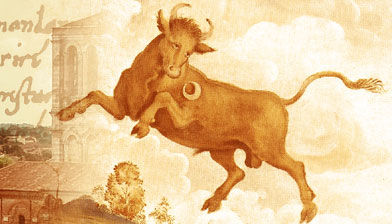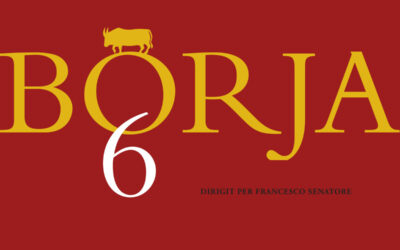Better to die in the saddle that in bed (Cesare Borgia, October 1503)
March 12th, 1507. He left this world in the way he always imagined: as a soldier, on the battlefield, fighting for his life to the last breath. In his last fight, he struggled alone, like a legendary knight, against a small army. But he was thrown from his horse and was stabbed to death multiple times with lances and daggers. His armor and clothes were removed and the body was abandoned. None of the assassins knew who he was.
In the summer of 1503, nothing seemed to announce the doom that will shatter in a second the ambitions and the dreams of that daring and impressive Duke of Romagna, Cesare Borgia. The cruel face of the destiny had broken everything that he built in those extraordinary five years (1498-1503), with energy, courage and brilliance; and, undoubtedly, with the direct assistance of his father, Pope Alexander VI.
The fall of Cesare Borgia began soon after his father’s death, which occurred on August 18th, 1503. Without his essential support in those great times of political and military triumphs, and touched by a serious illness, the Duke of Romagna made the strategic error that ultimately brought his terrible downfall. According to the most illustrious analyst of his times, Niccolò Machiavelli, Cesare’s involvement in the October’ papal elections in favor of Giuliano della Rovere, his family’ longtime foe, was the choice that accelerated his decline. „Unable to make a Pope of his own choice, yet he could prevent the election of any one that was not acceptable to him” (Machiavelli, The Prince, Chapter VII).
With this judgment clouded by the new Pope’s promises, Cesare Borgia signed his own death sentence. He actually believed that he could remain the Captain General of the papal army. Unfortunate for him, his mortal enemy would not allow this to happen. Under the pontificate of Julius II, this delusion quickly vanished.
It soon became obvious that Julius’ pledges were mere lies. However, Cesare still hoped that he will keep not only his freedom, but also his possessions in the center of Italy. Surprisingly (or maybe not), the people of Romagna have remained faithful to him to the bitter end.
He left the Eternal City, for the last time. His intention was to travel to France, to join his wife and the daughter he had never seen. Arrested at Ostia by Pope’s order, he was released due to the Spanish cardinals and his loyal lieutenants of Romagna and he embarked to Naples. It was the end of February, 1504.
In Naples he was the guest of Gonsalvo de Córdoba, who shared his plan to attack Florence and gave his support to build an army. When his intelligence informed him about this new scheme, Julius II demanded immediately the detention of Cesare. Gonsalvo has complied. He was under the command of Ferdinand of Spain, Pope’s ally. On May 26th, 1504, he ordered Borgia’s arrest. Another betrayal whose victim was Cesare Borgia…
In August 1504, the former Captain General of the Church left the Italian soil for good. Of course, he did not know that at the time. He has arrived in Spain and was transferred to the fortress-prison of Chinchilla. Imprisoned by King Ferdinand, deceived by Pope Julius II and abandoned by his former ally, Louis XII of France. What a terrible outcome for the once powerful Duke of Valentinois!
A prisoner as dangerous as Cesare Borgia was unsafe at Chinchilla. Unsafe for Spain and Rome, of course. Thus, in the summer of 1505, from the order of the Spanish Monarch, the Duke was incarcerated in the most secure prison in Spain – La Mota, at Medina del Campo. Due to the prison governor, who admired him and considered that his carrier has not yet come to an end, his captivity was softer that it was expected. Three months after his incarceration, on the night of October 25th, Borgia managed to escape. With the help of the governor and the assistance of some reliable men, Cesare Borgia became once again a fugitive.
Badly wounded during his escape, he remained hidden until he was able to leave for Navarre, the kingdom of his brother-in-law, Jean d’Albret. On December 3rd, he arrived to Navarre’s capital of Pamplona. At the court of his wife’s brother, Cesare hoped that, by political maneuvers and through his old allies, he will regain his former glory and, of course, the properties that once belonged to him. His appeals to French King and Francesco Gonzaga were useless. Neither of them was willing to break the alliance with the Supreme Pontiff of Rome, for the sake of a man politically dead. Julius II, Ferdinand of Spain and Louis XII turned their back on Cesare Borgia once and for all.
Almost all was lost for the son of Alexander VI. Repudiated by Italy, France and Spain, he received a one last job for the benefit of his host, the King of Navarre. In January 1507 Borgia was appointed commander of his army. Navarre was on a verge of civil war and Jean d’Albret needed a vigorous and experienced soldier to lead his troops. Full recovered from his injuries, Cesare was described by a contemporary as “a big man, strong, handsome, and in the full flight of his manhood”.
In the first days of March, Borgia led his troops to Viana, a small city held by a rebellious character named Luis of Beaumonte. In the early morning of March 12th, 1507, Cesare was awakened due to an attempt to break the siege, by the rebel army. A chaos was created and the Navarrese commander rode in pursuit after the enemy troops. In a confusing moment, the captain was left alone and drove his enemies into a ravine. He was ambushed, overwhelmed and massacred. Beaumonte’s men had no idea who they just killed. Cesare Borgia had died on Spanish ground, at thirty-one years old.
Jean d’Albret demanded that the body of his commander and brother-in-law to be taken to the church of Santa Maria of Viana and put in a tomb in the front of the high altar. Upon the imposing monument erected in Cesare Borgia’s memory, a thrilling epitaph was written in Spanish:
Here lies in a little earth
he, who everyone feared,
he, who peace and war
held in his hand.
Oh, you who go in search
of worthy things to praise,
if you could praise the worthiest
then your path stops here
and you do not need to go any farther.
Few decades later, the bishop of Calahorra, horrified that a man like Cesare Borgia was buried in the local church, ordered the demolition of the monument. Also, the remains were removed, disposed in a hole outside the church and paved over.
After centuries of controversies, public and historical debates and dozens of appeals, a man of God, Fernando Sebastián Aguilar (at the time, the Archbishop of Pamplona; today, a Cardinal of the Roman Church), decided that the true justice must be done. Ten years ago, on March 11th, 2007, Cesare Borgia’s remains were moved back into the church. “We have nothing against the transfer of his remains. Whatever he may have done in life, he deserves to be forgiven now”, said the Church representative. Wonderful words, that history will always remember…





